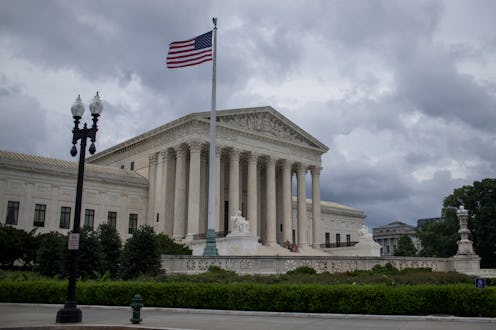News
What To Know About "Court-Packing" Because SCOTUS Isn't Limited To Just 9 Members

On Monday evening, President Trump is slated to announce his nominee to replace Supreme Court Justice Anthony Kennedy. Trump's nomination of a new SCOTUS justice has promoted concern among progressives, with some even suggesting pushing for a controversial strategy, called court-packing, to counter the court's conservative leanings. You may be wondering what exactly court-packing is amidst these discussions about the future of the United States' most powerful judicial institution. The strategy centers on the notion that the Supreme Court is not limited to only nine justices — and it has played an important part in America's political history before.
As Vox described, the Supreme Court is not required to have only nine justices. The Constitution does not mandate a number of justices and, therefore, the number is determined by Congress — and can be changed. The last time Congress changed the number of justices (to nine) was in 1869.
Court-packing involves a party increasing the number of justices on the Supreme Court in order to create a more balanced court and/or to create a court that is more in line with a party's political leanings. In the case of today's Democrats, some have suggested that, if the party regains control of Congress and the presidency in the future, it should pass legislation to increase the number of justices on the Supreme Court. Advocates of the court-packing strategy see it as one of the few ways to ensure that progressive legislation is upheld in years to come, since, as it stands now, SCOTUS will be decidedly conservative-leaning for the foreseeable future.
In an article in Jacobin last month, Todd N. Tucker, a political scientist and fellow at the Roosevelt Institute, argued that court-packing is necessary in modern times, because he believes it will help protect against extreme viewpoints and ensure that people's rights are protected. As Tucker described,
A thoughtful court-packing proposal would ensure that the Court more carefully reflects the mores of the time, rather than shackling democracy to the weight of the past. With inequality and human rights abuses spiraling upward and justices making it all worse, the time to begin mainstreaming an enlarged Court is now.
However, others, including many progressives, are very hesitant about the idea of court-packing, with some arguing that it sets a worrisome precedent. As Ilya Somin, a professor of law at George Mason University, argued in an article in the Volokah Conspiracy, a legal blog, court-packing could potentially threaten the legitimacy of the Supreme Court — and allow parties to use it as a political tool, moving it away from its role as an independent judicial check on power. As Somin wrote:
[Court-packing would not] leave the judiciary intact as a serious check on the power of the other branches of government ... Once the norm against it is broken, both parties will resort to it whenever they have simultaneous control over Congress and the presidency, thereby foreclosing any significant judicial review of their policies.
The last time a significant push for court-packing occurred in the United States was during the presidency of Franklin Roosevelt in the 1930s. At the time, many of Roosevelt's progressive New Deal policies were being struck down by the Supreme Court and, as a result, Roosevelt started pushing to increase the court's size to up to 15 justices in order to ensure that his legislation would be upheld. While Roosevelt's court-packing plan ultimately failed in the Senate, the strategy received a great deal of attention and perhaps even set the precedent for present-day discussions on the issue.
While it is being discussed as a possibility, in reality court-packing likely still remains somewhat of a long shot for Democrats. For a court-packing measure to pass, the party would have to regain control of the presidency and of both houses of Congress, including a filibuster-proof majority in the Senate. Moreover, the Democratic party would also have to decide that it is comfortable permanently resetting norms around the nature of the Supreme Court, something which could have significant ramifications for years on end.
Nonetheless, Trump's forthcoming nomination of a second Supreme Court justice has certainly sparked some intensive discussion about the possibility of instituting court-packing in the future. Time will tell if this controversial strategy becomes a reality.